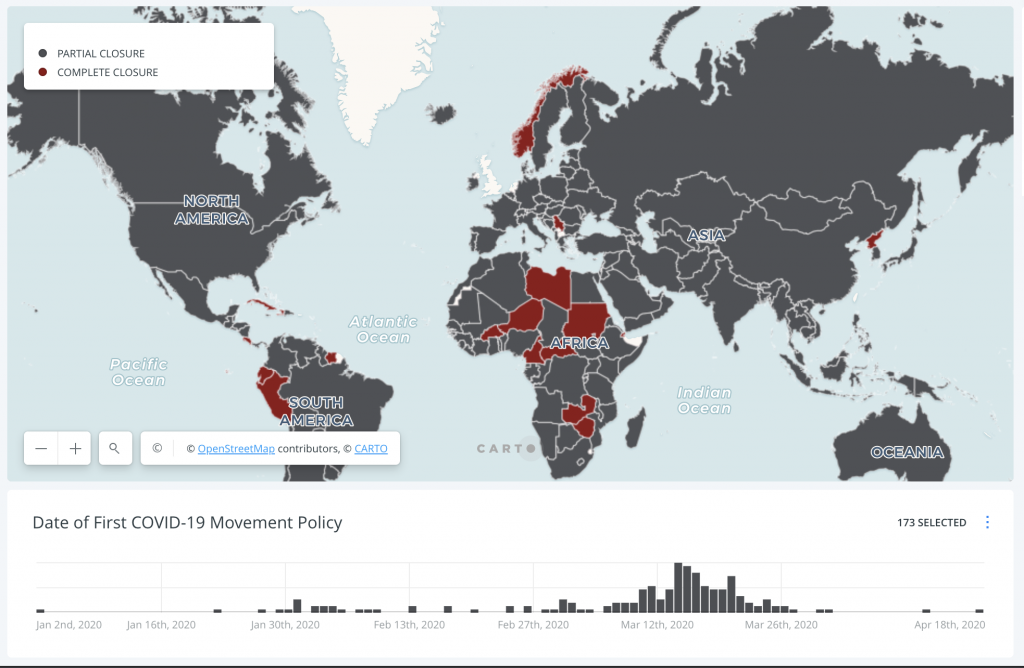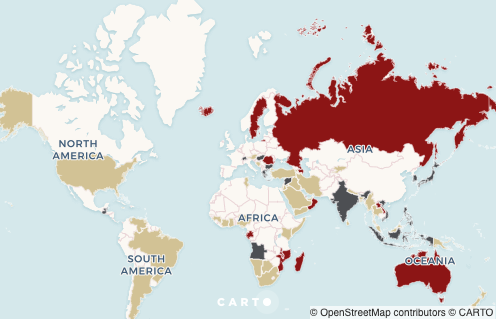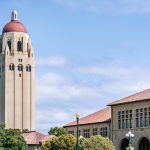Mapping the pandemic’s effects on migration and travel around the world.
by Jennifer Fei, Mary Shiraef, and Jessica Sadye Wolff
Well before the World Health Organization (WHO) officially declared COVID-19 a global pandemic, many countries had closed their borders or tightened their travel policies in response to the public health crisis. Soon after, nearly every other country in the world introduced movement restrictions and travel bans to try to slow the spread of the virus. Are the new restrictions temporary, or do they signal a global trend toward greater limitations on the freedom of movement?
The WHO has made it clear that it does not recommend that member states impose travel and trade restrictions in response to COVID-19. This position is in line with their guidance to focus on vigilance in screening and spread prevention rather than travel bans in response to the Ebola outbreak. Scholars of global health policies have also suggested that border closures and international travel restrictions on their own cannot stop or contain the spread of a disease, and can even have harmful effects by limiting trade and access to aid.
Despite these recommendations, between February 2 and May 12, at least 183 countries closed a border, suspended international flights, restricted visa services, or implemented a combination of these policies. Early on, most countries opted for targeted measures, such as mandatory quarantines for arriving travelers or limiting incoming flights from known hotspots, such as China and Italy. Since then, countries have pursued comprehensive measures, such as banning recreational and commercial travel, halting visa and asylum programs, and closing borders to non-citizens.
Taking this global view of COVID-19 response policies reveals a broad shift toward restrictions on international mobility during the first few months of the pandemic. Our pivotal question is whether these initial, sweeping policy responses will morph into broader, permanent agendas restricting immigration and movement. Now, several months after the WHO’s declaration of the COVID-19 pandemic, it is important to continue to track the persistence and types of country-level movement restrictions to understand how these unprecedented bans affect migration policy over time.
Initial Policy Responses
One way to track policy responses over time is to examine when countries first restricted international movement in response to COVID-19 and visualize these policies geographically, by closure type (partial or complete), and over time on a map. To build this map, we relied primarily on the travel-related restrictions recorded in the ACAPS COVID-19 Government Measures dataset, which tracks country-level policy changes since January 2020. The time slider on the map illustrates that many countries enacted their first policies in the days immediately following the WHO pandemic declaration on March 11, 2020. We found that the first movement-related response of most countries was to restrict movement through partial closures, rather than restricting access altogether through complete closures. Sixteen countries implemented a complete closure as their first movement-related policy.

A partial closure applies only to specific groups of people—groups defined by travel history or citizenship—or to a specified land, sea, or air border. A complete closure restricts access to all newcomers, either by closing land, sea, and air borders or by suspending all entry visas, with exceptions for citizens, permanent residents, those with extreme humanitarian or diplomatic reasons for travel, family members, dignitaries, cargo, commercial purposes, essential deliveries. In both categories, closures can be implemented with a single policy or through the cumulative effect of several policies.
Status-Based Bans
Migration policy experts have suggested that some governments are pushing through hardline policies that cannot be justified by public health concerns. Such restrictions can create real and unprecedented disruptions in people’s lives by separating families, cutting off access to job and education opportunities, and preventing resettlement for refugees and asylum seekers.
We relied primarily on the ACAPS dataset to depict the variation in bans based on an individual’s passport status, such as their citizenship and/or recent travel history. We found that while the majority of government restrictions were based on geographic borders, around 40 percent of countries introduced entry bans on the basis of an individual’s citizenship or recent travel history. Of the countries using status-based bans as of May 18, 15 countries based their travel bans on citizenship, and 16 countries’ policies were based on both citizenship and travel history.
This map shows countries that restricted cross-border movement based on individuals’ citizenship or recent travel histories:

During a global pandemic, a travel history-based ban may seem like an intuitive response, especially for those coming from countries with high transmission rates. However, the public health travel recommendations from the WHO, updated in response to the COVID-19 pandemic, advised comprehensive screening and contact tracing for passengers from affected areas over travel bans, except in specific cases and for no more than a few days.
We were surprised to find such a high prevalence of bans based not only on individuals’ recent travel history but also on individuals’ citizenship alone. For instance, Cambodia banned entry for foreigners from five countries with high transmission rates (Italy, Germany, Spain, France, and the United States), effective March 17 for thirty days, but it did not specify whether the ban applies only to foreigners with passports from these countries or anyone traveling from these countries. The Cambodian Ministry of Health’s official statement, released on Facebook, also did not specify why other countries with comparably high transmission rates, such as Iran, South Korea, Japan, or China were not targeted with the ban. What are the longer-term impacts of these status-based bans?
An Emerging Research Agenda
In recent weeks, countries have begun to reopen slowly to international travel and movement. However, for a subset of countries, existing movement restrictions may lead to longer-term legislative changes to mobility, travel, and immigration programs. We are particularly concerned about the pandemic’s negative impact on refugee and asylum seeker admissions and visa programs worldwide. For instance, Greece announced a formal plan for opening to tourists for summer 2020 while simultaneously extending lockdowns for those living in migrant encampments. How long will the movement of individuals with specific citizenships be affected by COVID-19? How long will they be prevented from pursuing employment opportunities or reuniting with family abroad? Will these policies outlast the pandemic, establishing a “new normal” for cross-border movement?
Given the far-reaching effects of restricting mobility, it is important to track if and when policy changes made during the initial peak of the pandemic are reversed. Systematized data collection of these border policies is an important first step toward deeper study of the pandemic’s effect on global migration policy. Several research groups, such as the CoronaNet Research Project and Oxford University’s Coronavirus Government Response Tracker, have captured trends across dimensions of cross-border movement restrictions, social distancing, economic policies, and lockdowns, among others. At least two major studies, one in Science and one in Nature, have produced results that isolate the impact of travel restrictions on the spread of COVID-19. A crucial parallel question is whether these unprecedented restrictions on human movement will have long-term socioeconomic effects on migration, economic development, and public health. Establishing approaches to capture these unprecedented policy changes over time is a challenging and necessary aspect of this new research agenda.
Jennifer Fei is a program manager at the Immigration Policy Lab (IPL) at Stanford University, leading a research portfolio that develops policies and programs to support refugee and immigrant integration.
Mary Shiraef is a visiting graduate student from the Department of Political Science at the University of Notre Dame. She studies processes of migration and identity politicization, with a focus on how collective memory takes shape in authoritarian regimes.
Jessica Sadye Wolff is also a program manager at IPL and manages projects under the Migration and Development Initiative.







